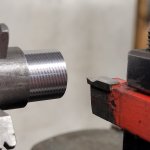camaro_dan67
Cast Iron
- Joined
- Dec 4, 2009
- Location
- N.E. Pa.
I have a 9 inch south bend with the flat belt drive and a gearbox I added to it. Its driven by a 1.5 hp motor that I replaced the original 3/4 hp with. My problem is a striped finish no matter what I do. I tried different tooling with a different radius on the tools. I tried different depths of cut but nothing seems to help. I also tried different feed rates, oil, coolant. I just cant get a nice finish. What else do I try?




